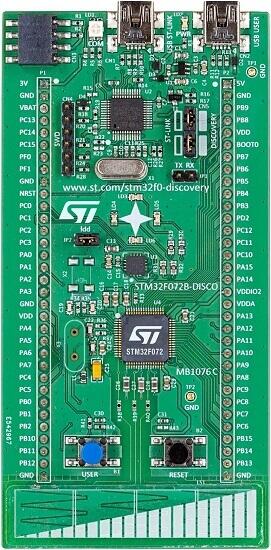ST STM32F072B Discovery
Overview
The STM32F072B-DISCO Discovery kit features an ARM Cortex-M0 based STM32F072RB MCU with everything required for beginners and experienced users to get started quickly. Here are some highlights of the STM32F072B-DISCO board:
STM32 microcontroller in LQFP64 package
Extension header for LQFP64 I/Os for a quick connection to the prototyping board and easy probing
On-board ST-LINK/V2, debugger/programmer with SWD connector
Board power supply: through USB bus or from an external 5 V supply voltage
External application power supply: 3 V and 5 V
Six LEDs:
LD1 (red/green) for USB communication
LD2 (red) for 3.3 V power on
Four user LEDs: LD3 (orange), LD4 (green), LD5 (red) and LD6 (blue)
Two push-buttons: USER and RESET
USB USER with Mini-B connector
L3GD20, ST MEMS motion sensor, 3-axis digital output gyroscope
One linear touch sensor or four touch keys
RF EEprom daughter board connector

More information about the board can be found at the STM32F072B-DISCO website [1].
Hardware
STM32F072B-DISCO Discovery kit provides the following hardware components:
STM32F072RBTT6 in LQFP64 package
ARM® 32-bit Cortex® -M0 CPU
48 MHz max CPU frequency
VDD from 2.0 V to 3.6 V
128 KB Flash
16 KB SRAM
GPIO with external interrupt capability
12-bit ADC with 39 channels
12-bit D/A converters
RTC
General Purpose Timers (12)
USART/UART (4)
I2C (2)
SPI (2)
CAN
USB 2.0 full speed interface
DMA Controller
24 capacitive sensing channels for touchkey, linear and rotary touch sensors
- More information about STM32F072RB can be found here:
Supported Features
The Zephyr stm32f072b_disco board configuration supports the following hardware features:
Interface |
Controller |
Driver/Component |
|---|---|---|
NVIC |
on-chip |
nested vector interrupt controller |
UART |
on-chip |
serial port-polling; serial port-interrupt |
PINMUX |
on-chip |
pinmux |
GPIO |
on-chip |
gpio |
CLOCK |
on-chip |
reset and clock control |
WATCHDOG |
on-chip |
independent watchdog |
I2C |
on-chip |
i2c controller |
SPI |
on-chip |
SPI controller |
CAN |
on-chip |
CAN controller |
Note
CAN feature requires CAN transceiver, such as SK Pang CAN breakout board [5].
Other hardware features are not yet supported in this Zephyr port.
The default configuration can be found in the defconfig file:
boards/arm/stm32f072b_disco/stm32f072b_disco_defconfig
Pin Mapping
STM32F072B-DISCO Discovery kit has 6 GPIO controllers. These controllers are responsible for pin muxing, input/output, pull-up, etc.
For mode details please refer to STM32F072B-DISCO board User Manual [2].
Default Zephyr Peripheral Mapping:
UART_1_TX : PB6
UART_1_RX : PB7
I2C1_SCL : PB8
I2C1_SDA : PB9
I2C2_SCL : PB10
I2C2_SDA : PB11
SPI1_SCK : PB3
SPI1_MISO : PB4
SPI1_MOSI : PB5
USER_PB : PA0
LD3 : PC6
LD4 : PC8
LD5 : PC9
LD6 : PC7
CAN_RX : PB8
CAN_TX : PB9
System Clock
STM32F072B-DISCO System Clock could be driven by internal or external oscillator, as well as main PLL clock. By default System clock is driven by PLL clock at 72 MHz, driven by internal 8 MHz oscillator.
Serial Port
STM32F072B-DISCO Discovery kit has up to 4 UARTs. The Zephyr console output is assigned to UART 1. Default settings are 115200 8N1.
Programming and Debugging
Applications for the stm32f072b_disco board configuration can be built and
flashed in the usual way (see Building an Application and
Run an Application for more details).
Flashing
STM32F072B-DISCO board includes an ST-LINK/V2 embedded debug tool interface. This interface is supported by the openocd version included in the Zephyr SDK.
Flashing an application to STM32F072B-DISCO
First, connect the STM32F072B-DISCO Discovery kit to your host computer using the USB port to prepare it for flashing. Then build and flash your application.
Here is an example for the Hello World application.
# From the root of the zephyr repository
west build -b stm32f072b_disco samples/hello_world
west flash
Run a serial host program to connect with your board. A TTL(3.3V) serial adapter is required.
$ minicom -D /dev/<tty device>
Replace <tty_device> with the port where the serial adapter can be found. For example, under Linux, /dev/ttyUSB0.
You should see the following message on the console:
Hello World! arm
Debugging
You can debug an application in the usual way. Here is an example for the Hello World application.
# From the root of the zephyr repository
west build -b stm32f072b_disco samples/hello_world
west debug
